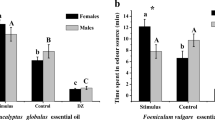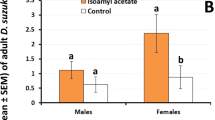Abstract
The egg dispersion strategy of the olive fruit flyDacus oleae, which is dependent on chemicals from the fruit, was investigated. In particular, the exact role ofo-diphenolic compounds, such as the typical olive glucosides, oleuropein and demethyloleuropein, and their derivatives was clarified. It appears that the strong chemotactile repulsive effect exerted by the water fraction of crushed olives is due mainly to (E)-2-hexenal. Several compounds, such asβ-3,4-dihydroxyphenylethanol and other oleuropein derivatives, which exert a strong chemotactile repulsion, were newly identified or confirmed either in fresh olive juice or in olive mill waste water. This result confirms that the small droplets of olive juice, regurgitated just after egg laying by theD. oleae female all around the oviposition hole, actually prevent other females from ovipositing on the same fruit.
Similar content being viewed by others
References
Balice, V., andCera, O. 1984. Acidic phenolic fraction of the olive waste water determined by a GC method.Grasas Aceites 35:178–180.
Bianco, A., Lo Scalzo, R., andScarpati, M.L. 1993. Isolation of cornoside fromOlea europaea and its transformation into Halleridone.Phytochemistry 32:455–457.
Cirio, U. 1971. Reperti sul meccanismo stimolo-risposta nella ovideposizione delDacus oleae (Gmel.).Redia 52:577–600.
Cirio, U., andVita, G. 1976. Natural chemical substances affecting cherry fruit fly behaviour. I. Laboratory trials.Boll. Lab. Entomol. Agric. Portici 33:301–314.
Cirio, U., andVita, G. 1980. Fruit fly control by chemical attractans and repellents.Boll. Lab. Entomol. Agric. Portici 37:127–139.
Duncan, D.B. 1955. Multiple range and multiple F tests.Biometrics 11:1–42.
Fiume, F., andVita, G. 1977. L'impiego delle acque di vegetazione del frutto di olivo per il controllo delDacus oleae (Gmel.) in pieno campo.Boll. Lab. Entomol. Agric. Portici 34:25–37.
Gariboldi, P., Jommi, G., andVerotta, L. 1985. Secoiridoids fromOlea europaea, L.,Phytochemistry 25:865–869.
Girolami, V., andStrapazzon, A. 1982. II Incontro sulDacus oleae: attrattività della pianta ospite, stimolazione e regolazione della fecondità inDacus oleae (Gmel.).Frustula Entomol. 4:247–255.
Girolami, V., Pellizzari, G., Ragazzi, E., andVeronese, G. 1974. Prospects of increased egg production in the rearing ofDacus oleae (Gmel.) by the use of chemical stimuli. Proceedings of the symposium: Sterility Principle of Insect Control, IAEA, Wien, 1975, pp. 209–217.
Girolami, V., Vianello, A., Strapazzon, A., Ragazzi, E., andVeronese, G. 1981. Ovipositional deterrents inDacus oleae (Gmel.).Entomol. Exp. Appl. 29:177–188.
Hatanaka, A., Kajiwara, T., andSekiya, J. 1986. Fatty acids hydroperoxide lyase in plant tissues: Volatile aldehyde formation from linoleic and linolenic acid, pp. 99–111,in T. H. Parliment and R. Croteau (eds.). Biogeneration of Aromas, ACS Symposium Series No. 117. American Chemical Society, Washington, D.C.
Mazzini, M., andVita, G. 1981. Identificazione submicroscopica del meccanismo di trasmissione del batterio simbionte inDacus oleae (Gmel.) (Diptera, Trypetidae).Redia 64:277–301.
Panizzi, L., Scarpati, M.L., andOriente, G. 1960. Costituzione della oleuropeina, glucoside amaro e ad azione ipotensiva dell'olivo. Nota II.Gazz. Chim. Ital. 90:1449–1485.
Scarpati, M.L., Lo Scalzo, R., andVita, G. 1993.Olea europaea L. volatiles attractive and repellent to the olive fruit fly (Dacus oleae, Gmelin).J. Chem. Ecol. 19:881–891.
Scarpati, M.L., andLo Scalzo, R. 1993. A new secoiridoid from olive waste waters.J. Nat. Prod. 56:621–623.
Ullmann's Encyclopedia of Industrial Chemistry, A10:176. Ed. VCH 1987. Weinheim.
Vita, G., andBarbera, F. 1976. Aspetti biochimici del rapporto pianta-insetto nelDacus oleae (Gmel.).Attix Congr. Ital. Entomol. 11:151–161.
Vita, G., andCirio, U. 1977. Testing the response ofDacus oleae to oviposition deterring substances. Technical internal report. CNEN RT/BIO (79) 29, pp. 1–3.
Vita, G., Cirio, U., Fedeli, E., andJacini, G. 1977. L'uso di sostanze naturali presenti nell'oliva come prospettiva di lotta contro ilDacus oleae (Gmel.).Boll. Lab. Entomol. Agric. Portici 34:55–61.
Author information
Authors and Affiliations
Rights and permissions
About this article
Cite this article
Lo Scalzo, R., Scarpati, M.L., Verzegnassi, B. et al. Olea europaea chemicals repellent toDacus oleae females. J Chem Ecol 20, 1813–1823 (1994). https://doi.org/10.1007/BF02066224
Received:
Accepted:
Issue Date:
DOI: https://doi.org/10.1007/BF02066224




